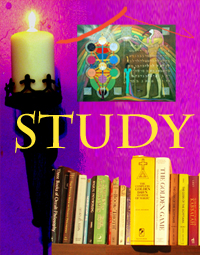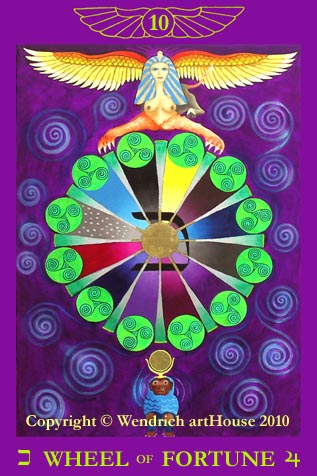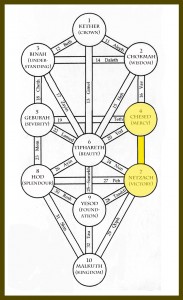Key 10: Wheel of Fortune
The Lord of the Forces of Life
“The Twenty-first Path is the Intelligence of Conciliation, and is so called because it receives the divine influence which flows into it from its benediction upon all and each existence.” (Sepher Yetzirah)
The Twenty-first Path is the Intelligence of Conciliation and Reward, and is so-called because it receives the divine influence which flows into it from its benediction upon all and each existence.
I have always liked the appearance of the Wheel of Fortune in a reading. It immediately implies change, new experiences, growth and reward. In the long history of fortune-telling, the Wheel of Fortune, which symbolizes the celestial map of the heavens, was itself once used as a tool for divination. Babylonian mysteries, using the principle that the universe revolved around our Sun, placed the Sun at the centre of the wheel, the spokes of which represented the days of the solar year. As the wheel turned, the spokes could point to certain celestial bodies around the rim, and if a line could be drawn from the centre (the Sun) along a spoke to a planet, then that particular celestial sphere was considered to affect the fortune of the day, both in general and personally. Such an interpretation involved a complex mathematical calculation based upon magic, mysticism, and magnetism, influencing the development of our modern day astrology.
The 21st Path lies between Chesed and Netzach. It is in Chesed that the true reflection of the soul’s will is held by karmic forces. As it flows down to Netzach and attempts to manifest through the creative imagination it experiences the pull of magnetic attraction.
The Hebrew letter associated with this card is Kaph, which means ‘fist’ or ‘palm of the hand’. In this card, we see it holding the centre in place. Kaph is one of the seven double letters which make two sounds, one soft and one hard. This duality is reflected in the underlying meaning of the card – the transitions between prosperity and poverty, life and death, etc. Kaph also has a final letter which symbolizes individual attainment.
In the Portal ritual when the Candidate attempts to walk the Path of Kaph, he or she finds that it is called the Path of Aspiration. They are warned that temerity is not courage, and are reminded of the lesson of the Tower struck by Lightning. “As a house built upon the sand cannot endure, so without the strength of Geburah the height of Chesed cannot be scaled.” They are told to stay lest their limbs be broken upon the Wheel of Life and Death, and “hard it is to be freed from that Wheel.” Aspiration is the “will to succeed” and the message of the Portal is that to master this card you need the strength of Geburah. Aspiration is the drive of God which over comes the fate of the wheel, that of life and transmutation. Geburah drives the swinging action of the wheel towards a central unity. This is the lesson of Buddhism.
The Sphinx lies above as if controlling the wheel, but does not touch it. She represents the synthesis of the four elemental forces, further symbolised by her eagle wings, human head and breast, lion’s claws and tail, and body of a bull, reminding us of Ezekiel’s vision of the four Kerubim and the wheels within wheels. Again we are reminded of the Portal ritual, where the four elements are bought into balance so that Spirit may dwell in the centre.
The ape at the bottom of the card is called Cynocephalus, sacred to the lunar god Thoth. He was also an emblem of secret wisdom. The ape god was considered to be phallic, in contrast to the more feminine Sphinx above. Cynocephalus was said to be highly intelligent and was instrumental in the weighing of the heart in the Hall of Judgement. The ancient Egyptian firmly believed in reincarnation and that the tomb that held the body after one’s life was like a womb of the life yet to come.
The wheel itself is constructed of 12 segments which correspond with the Zodiacal signs, and they are coloured in Queen Scale, bringing a feminine quality. Jupiter is also assigned to this card, but that is no assurance of beneficial influence for it can also turn against ones luck. Either way, it guarantees that life is on the move! This ever-turning wheel of time and fate generates the continual flow of the forces of life and death, and hence the ever-growing spiral of evolution governed by the forces of Karma (the laws of cause and effect).
The wheel is also that of King Arthur’s Round Table, which was a meeting place for the stellar forces of the zodiac (represented by the Knights). The Wheel of Fortune draws together these agencies, which otherwise would split apart, so that the Universe might achieve its glorious, divine, destiny. It is a powerful focus for scattered divine energy to be bought together in a unity. The Round Table is a multi-dimensional symbol which becomes a spiral when seen on different levels.
This aspect of the Wheel of Fortune is encoded into the 0=0 ritual in the form of circumambulations before the Hierophant, who is the Higher Spiritual self (the Sphinx), and the Hiereus the Guardian against the dark forces (the Cynocephalus). Life, then, is a movement between light and darkness, good and bad experiences. We face challenges on that spiral but our life is on a cone, moving ever inwards and upwards, ever driven by whatever we aspire towards.
All circles have an invisible spiralling centre. The three circles of creation at the outer edge of the wheel represent wheels within wheels. These three spirals of the Celts also represent the spiritual evolutionary progress which will ultimately unite us to our Higher Selves.
Divination:
Good fortune. Natural change. Good luck. Things will get better. The Cycles of life. Taking control of one’s life; starting a new course. Increase of awareness and understanding through experience. Fate and destiny. Magnetism. Karma. If badly aspected: Fatal attraction. Bad luck. Life turning for the worse.



